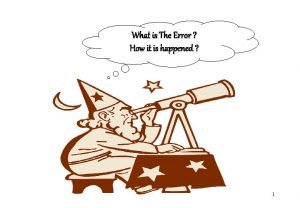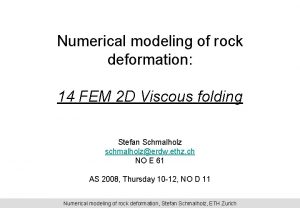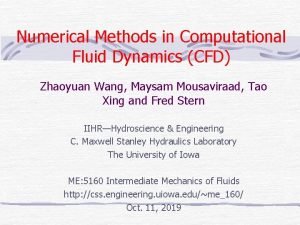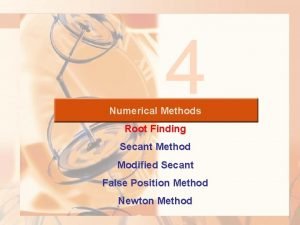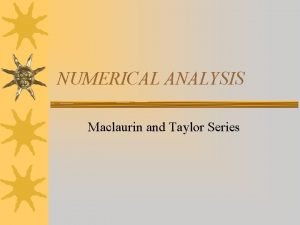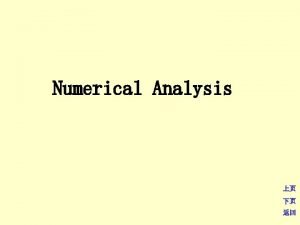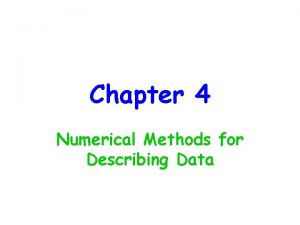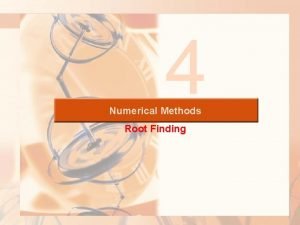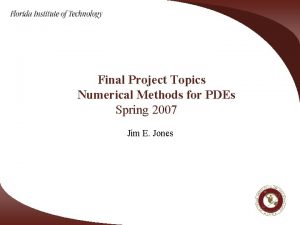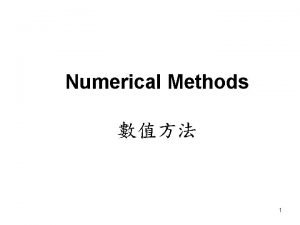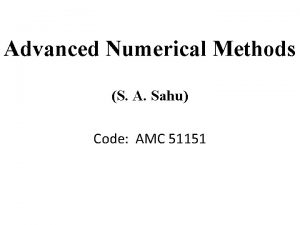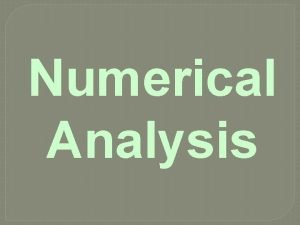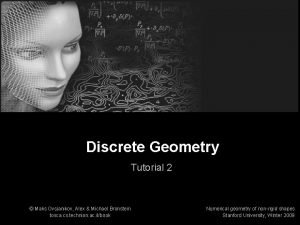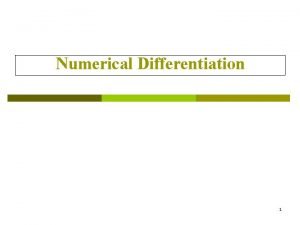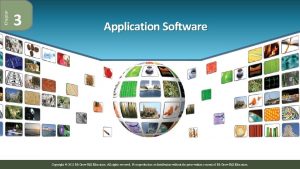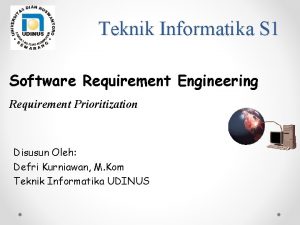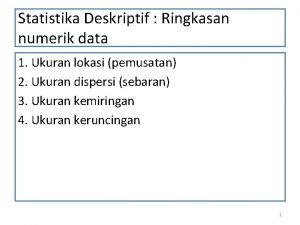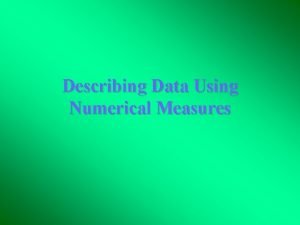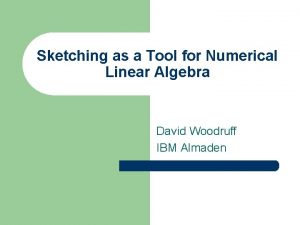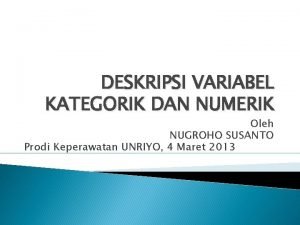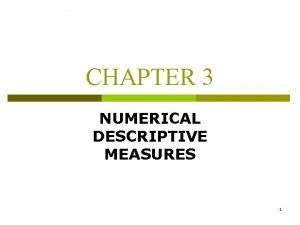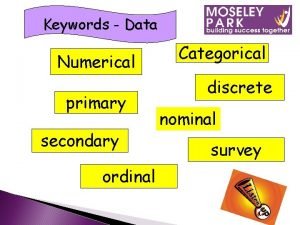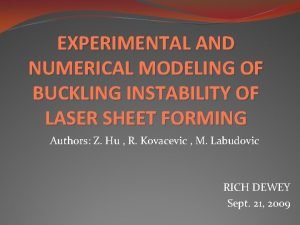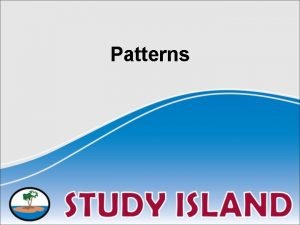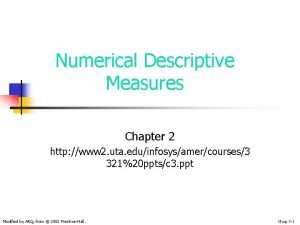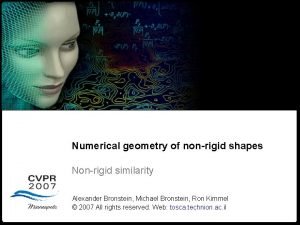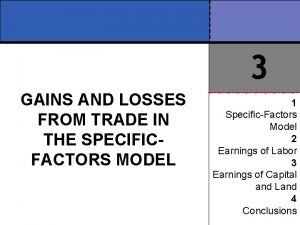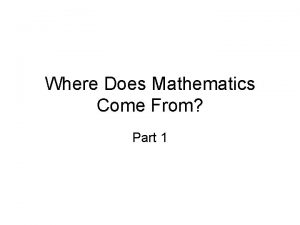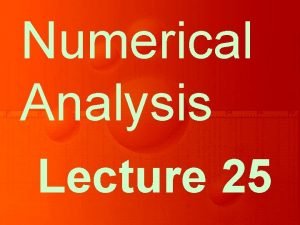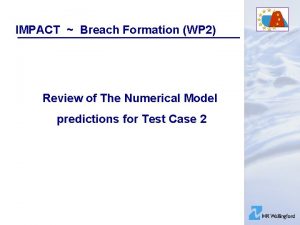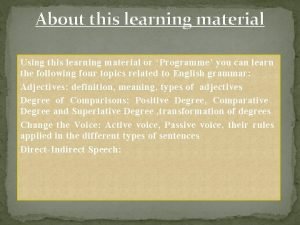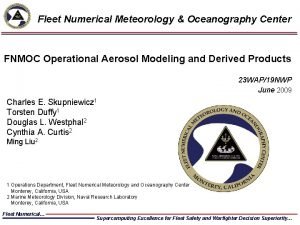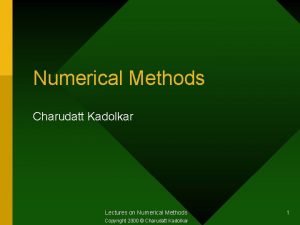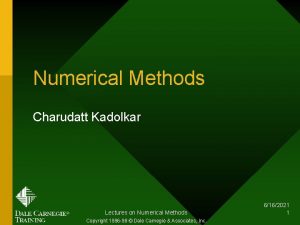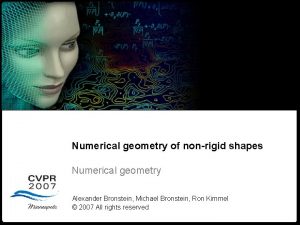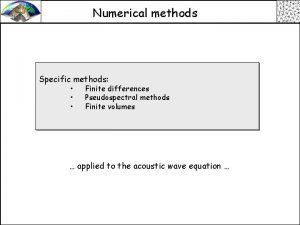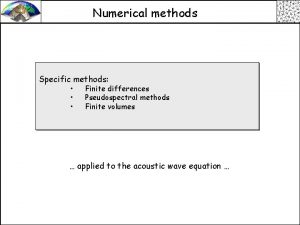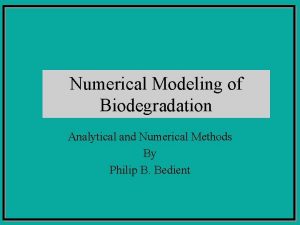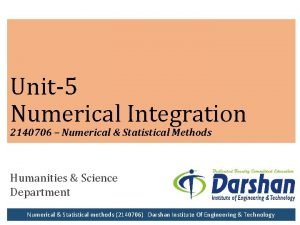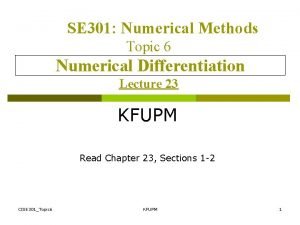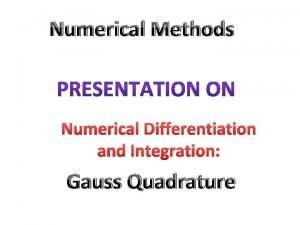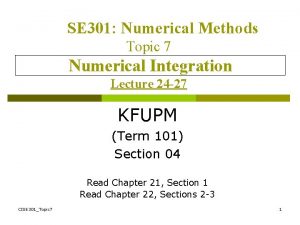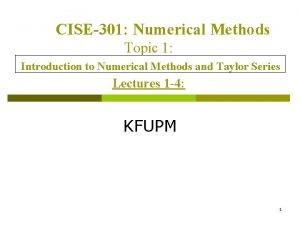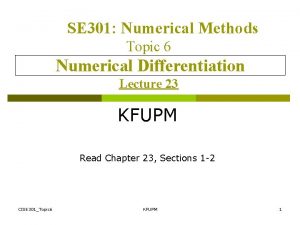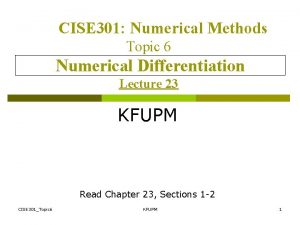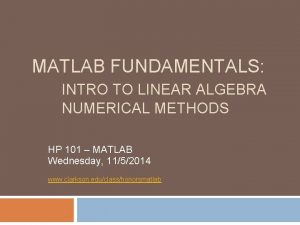Numerical Methods Intro to Numerical Methods Intro to













































- Slides: 45

Numerical Methods Intro to Numerical Methods & Intro to Matlab Programming By M Jamil Khan

Numerical Methods What are numerical methods and why should you study them?

Numerical Methods “Numerical Methods are techniques by which mathematical Problems are formulated so that they can be solved with arithmetic and logical operations. Because digital computers excel at performing such operations, numerical methods are sometimes referred as computer mathematics”.

Numerical Methods In pre computer era , the time and effort of implementing such calculations seriously limited their practical use. However, with the advent of fast, inexpensive digital computers, the role of numerical methods in engineering and scientific problem solving has exploded.

Numerical Methods Numerical methods figure so prominently in, much of our Why? work, I believe that numerical methods should be a part of every engineer's and scientist's basic education. Just as we all must have solid foundation in the other areas of mathematics and science, we should also have a fundamental understanding of numerical methods. In particular, we should have a solid appreciation of both their capabilities and their limitations.

Numerical Methods 1 Beyond contributing to your overall education. . there are several additional reasons why you should study numerical methods:

Numerical Methods 1 2 Numerical methods greatly expand the types of , problems you can address. They are capable of handling large systems of equations nonlinearities, and complicated geometries that are not uncommon in engineering and science and that are often impossible to solve analytically with standard calculus. As such they greatly enhance your problem-solving skills.

Numerical Methods 3 2 Numerical methods allow you to use "canned“ software with insight. During your career, you will invariably have occasion to use commercially available pre-packaged computer programs that involve numerical methods. The intelligent use of these programs is greatly enhanced by an understanding of the basic theory underlying the methods. In the absence of such understanding you will be left to treat such packages as “black boxes“ with little critical insight into their inner workings or the validity of the results they produce.

Numerical Methods 3 4 Many problems cannot be approached using canned programs. If you are conversant with numerical methods, and are adept at computer programming, you can design your own programs to solve problems without having to buy or commission expensive software.

Numerical Methods 4 5 Numerical methods are an efficient vehicle for learning to use computers. Because numerical methods are expressly designed for computer implementation, they are ideal for illustrating the computer's powers and limitations. When you successfully implement numerical methods on a computer, and then apply them to solve otherwise intractable problems, you will be provided with a dramatic demonstration of how computer can serve our professional development. At the same time, you will also learn to acknowledge and control the errors of approximation that are part and parcel of large-scale numerical calculations.

Numerical Methods 5 Numerical methods provide a vehicle for you to reinforce your understanding of mathematics. Because one function of numerical methods is to reduce higher mathematics to basic arithmetic operations. they get at the "nuts and bolts" of some otherwise obscure topics. Enhanced understanding and insight can result from this alternative perspective.

Books Reference Books • A first Course in Numerical Analysis with C++ by Dr. Saeed Akhtar Bhatti, 4 th Edition. • Applied Numerical Methods using Matlab by Won Young Yang. • Applied Numerical Methods with Matlab for Engineers and Scientists by Steven C. Chapra, 2 nd Edition.

Grading Policy ü Unannounced Quizzes 20% ü Lab Assignments 20% + Attendance (Late and Missed Submissions are Not Applicable) + Discipline ü Mid Exam 20% ü Final Exam 40%

Computer Usage ü You should be able to write a computer code in a programming language you know such as MATLAB or C.

Some Useful Links http: //web. uettaxila. edu. pk/CMS/FA 2011/te. NMTbs/ http: //www. library. nu http: //www. google. com http: //www. codeproject. com http: //numericalmethods. eng. usf. edu http: //math. gmu. edu/introtomatlab. htm http: //www. mathworks. com

Feedback Request � Please mail questions and constructive comments to muhammad. jamil@uettaxila. edu. pk Your feedback will be most appreciated � On style, contents, detail, examples, clarity, conceptual problems, exercises, missing information, depth, etc. Local course support website � http: //web. uettaxila. edu. pk/CMS/SP 2011/te. NMTbs/

Course Objective This course will emphasize the development of numerical algorithms to provide solutions to common problems formulated in science and engineering. The primary objective of the course is to develop the basic understanding of the construction of numerical algorithms, and perhaps more importantly, the applicability and limits of their appropriate use.

Course Outline ü Introduction to Numerical Methods ü Introduction to Matlab Programming ü Error Analysis ü Finite Differences ü Interpolation ü Numerical Differentiation

Course Outline ü Numerical Integration ü Ordinary Differential Equations ü Non Linear Equations ü Linear System of Equations

Today Objectives The primary objective of today’s discussion is to provide you with a concrete idea of what numerical methods are and how they relate to engineering and scientific problem solving. Specific objectives and topics covered are • Learning how mathematical models can be formulated on the basis of scientific principles t o simulate the behavior of a simple physical system. • Understanding how numerical methods afford a means to generate solutions in a manner that can be implemented on a digital computer.

Today Objectives • Understanding the different types of conservation laws that lie beneath the models used in the various engineering disciplines and appreciating the difference • between steady-state and dynamic solutions of these models. Learning about the different types of numerical methods we will cover in this course.

A Simple Mathematical Model § A mathematical model can be broadly defined as a formulation or equation that expresses the essential features of a physical system or process in mathematical terms. § Models can be represented by a functional relationship between dependent variables, independent variables, parameters, and forcing functions.

Model Function § Dependent variable - a characteristic that usually reflects the behavior or state of the system § Independent variables - dimensions, such as time and space, along which the system’s behavior is being determined.

Model Function § Parameters - constants reflective of the system’s properties or composition § Forcing functions - external influences acting upon the system

Model Function Example Assuming a bungee jumper is in mid-flight, an analytical model for the jumper’s velocity, accounting for drag, is § Dependent variable - velocity v § Independent variables - time t § Parameters - mass m, drag coefficient cd § Forcing function - gravitational acceleration g

Model Results Using a computer (or a calculator), the model can be used to generate a graphical representation of the system. For example, the graph below represents the velocity of a 68. 1 kg jumper, assuming a drag coefficient of 0. 25 kg/m

Numerical Modeling l Some system models will be given as implicit functions or as differential equations - these can be solved either using analytical methods or numerical methods. l Example - the bungee jumper velocity equation from before is the analytical solution to the differential equation where the change in velocity is determined by the gravitational forces acting on the jumper versus the drag force.

Numerical Methods To solve the problem using a numerical method, note that the time rate of change of velocity can be approximated as:

Numerical Results The efficiency and accuracy of numerical methods will depend upon how the method is applied. Applying the previous method in 2 s intervals yields:

Analytical and Numerical Solutions: Numerical methods are techniques by which mathematical problems are formulated so that they can be solved with arithmetic and logical operations. Numerical Analytical approximate exact more intuitive less intuitive easily coded not so easy to get not so easy

Bases for Numerical Models Basic Needs in the Numerical Methods: l Practical: Can be computed in a reasonable amount of time. l Accurate: l l Good approximate to the true value, Information about the approximation error (Bounds, error order, … ).

Solution of Nonlinear Equations l Some simple equations can be solved analytically: l Many other equations have no analytical solution:

Methods for Solving Nonlinear Equations o Bisection Method o Newton-Raphson Method o Secant Method

Solution of Systems of Linear Equations

Cramer’s Rule is Not Practical

Methods for Solving Systems of Linear Equations o Naive Gaussian Elimination o Gaussian Elimination with Scaled Partial Pivoting o Algorithm for Tri-diagonal Equations

Curve Fitting l Given a set of data: l Select a curve that best fits the data. One choice is to find the curve so that the sum of the square of the error is minimized.

Interpolation l Given a set of data: l Find a polynomial P(x) whose graph passes through all tabulated points.

Methods for Curve Fitting o Least Squares o o o Linear Regression Nonlinear Least Squares Problems Interpolation o o Newton Polynomial Interpolation Lagrange Interpolation

Integration l Some functions can be integrated analytically:

Methods for Numerical Integration o Upper and Lower Sums o Trapezoid Method o Romberg Method o Gauss Quadrature

Solution of Ordinary Differential Equations

Solution of Partial Differential Equations are more difficult to solve than ordinary differential equations:

Bases for Numerical Models Conservation laws provide the foundation for many model functions. Different fields of engineering and science apply these laws to different paradigms within the field. Among these laws are: Conservation of mass Conservation of momentum Conservation of charge Conservation of energy

 Errors in numerical methods
Errors in numerical methods Numerical methods for partial differential equations eth
Numerical methods for partial differential equations eth Cfd numerical methods
Cfd numerical methods Modified secant method example
Modified secant method example Taylor series numerical methods
Taylor series numerical methods Interpolation in numerical methods
Interpolation in numerical methods Singular solution of ode
Singular solution of ode Numerical methods for describing data
Numerical methods for describing data Birge vieta method is used to find
Birge vieta method is used to find Types of errors in numerical methods
Types of errors in numerical methods Numerical methods final project
Numerical methods final project Numerical methods of descriptive statistics
Numerical methods of descriptive statistics Graphical and numerical methods
Graphical and numerical methods Numerical methods
Numerical methods Modified euler formula
Modified euler formula Gauss forward interpolation c program
Gauss forward interpolation c program Newtons backward interpolation
Newtons backward interpolation Direct wax pattern technique
Direct wax pattern technique Numerical analysis
Numerical analysis Turner syndrome is what numerical chromosome disorder?
Turner syndrome is what numerical chromosome disorder? Numerical geometry of non-rigid shapes
Numerical geometry of non-rigid shapes 1st derivative rule for forward and backward
1st derivative rule for forward and backward Programs that organize analyze and graph numerical data
Programs that organize analyze and graph numerical data Contoh user requirement
Contoh user requirement Ringkasan numerik
Ringkasan numerik Numerical
Numerical Sketching as a tool for numerical linear algebra
Sketching as a tool for numerical linear algebra What is a numerical summary of a sample
What is a numerical summary of a sample Numerical programming
Numerical programming Contoh variabel numerik dan kategorik
Contoh variabel numerik dan kategorik Variance and standard deviation formula
Variance and standard deviation formula Property of exponents
Property of exponents Categorical data vs numerical data
Categorical data vs numerical data Numerical modeling
Numerical modeling Numerical and geometric patterns
Numerical and geometric patterns Numerical descriptive measures
Numerical descriptive measures Numerical geometry of non-rigid shapes
Numerical geometry of non-rigid shapes Specific factors model numerical example
Specific factors model numerical example Numerical stroop
Numerical stroop Finite differences and interpolation
Finite differences and interpolation Reduced bearing system
Reduced bearing system Numerical model
Numerical model Abstrct nouns
Abstrct nouns Numerical integration of discrete data
Numerical integration of discrete data Xiaolin wu circle
Xiaolin wu circle Fleet numerical meteorology and oceanography center
Fleet numerical meteorology and oceanography center
